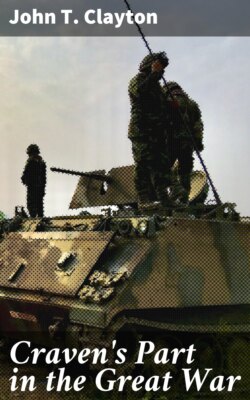Читать книгу Craven's Part in the Great War - John T. Clayton - Страница 19
На сайте Литреса книга снята с продажи.
COAST DEFENCE AND TRAINING.
ОглавлениеTable of Contents
Of Immingham, the Battalion has only confused memories of concrete floors as sleeping places, of endless tours of sentry-go, of its first experience of strict army rations, and of countless rumours to which unnecessary credence was given, since the troops had not yet learnt the tainted source from which such stories rise. Early one morning there was a particularly strong report of a great battle in the North Sea, and an officer asked a recruit just coming off duty if he had heard any firing in the night. “I’m very sorry, sir, it was me!” was the unexpected reply: “I let it off by accident.”
After about a week the battalion moved into billets at the pleasant and hospitable village of Healing, near Grimsby. Here they spent a happy and healthy month, and on Sept. 15th moved into camp in Riby Park, about four miles further inland. The weather was glorious and the physique of the battalion improved out of all knowledge. Faces and arms turned brown, packs and equipment felt lighter, and the marches over the Lincolnshire downs insensibly grew longer. During all this time both officers and men had been continually welcoming friends among the new recruits who came to take the places of those unfit for active service, under age, or whose circumstances prevented them from volunteering for work overseas. And when a cold wet spell at the end of October brought on a welcome move from tents into the warmer shelter of schools and other billets in Doncaster, it was a strong battalion of fit men, ready to go anywhere, that marched to the station.
At Doncaster the battalion settled down for the winter and made a vast number of firm friendships among the inhabitants, who had viewed the arrival of troops with some apprehension. The Christmas dinner, served in all the company billets, was a huge success, though there were already many who were sore that they were not yet in the trenches and feared that the war would be finished without them!
All this time progressive training had gone on. At Healing the battalion was alone in the village, and battalion and company drill were the usual order of the day. Riby was a Brigade camp, and the presence of the 4th, 5th and 7th Duke of Wellington’s and a battery of Artillery gave an added rivalry to the quest of military efficiency and to endurance in long marches. The harvest was now in and field manœuvres became possible, and the battalion received its initiation in trench digging. There was a good deal of musketry instruction and a little firing on an indifferent range. The signallers under Lieut. A. Slingsby and the machine-gunners under Lieut. B. R. Brewin improved enormously along their special lines; while the cyclists under 2nd Lieut. “Pedaller” Palmer tested their wind and muscles up the gradients of Swallow Downs. The Brigade was inspected at Brocklesby by Major-General Plumer, who was, in a few months’ time, to welcome them to his own particular salient of Ypres.
At Doncaster musketry practice was more seriously undertaken and, when the Cantley ranges overflowed, parties proceeded to all parts of Yorkshire. The field days, under the eye of Major-Gen. Baldock, commanding the Division, with an added force of Artillery, Royal Engineers and Divisional Cavalry, were on a larger scale, and the continual battles of Marr and Rossington Bridge taught officers to handle men, men to acquire something of an eye for country, and outposts to keep alert with eye and ear—particularly necessary if Lieut. Anthony Slingsby and his Scouts were on the opposing side. And if the night operations caused an annoying interference with more romantic engagements, they taught lessons in finding the way at night that proved valuable later on.
In the later stages trenches were dug, and one battalion relieved another in their occupation by night; billeting schemes were carried out in the surrounding villages, and the constant alarms of raids or invasion, which on one occasion brought the brigade scurrying back to billets from a field day, lent a feeling of reality to the training. About the same time the Machine Gun Section acquired for a few weeks an armoured motor-car of enormous dimensions, with which, after spreading terror and confusion among the children of the neighbourhood, they proceeded to patrol the East Coast from the Humber to Flamborough Head, to reassure the inhabitants who had been startled by the raid on Scarborough. As a fighting machine the vehicle might be open to criticism, but it possessed two Vickers guns and thus enabled the section to familiarize themselves with these weapons. It was a lucky chance, for they next met this gun when a number were dumped upon them, without further instruction, in the unspeakable trenches of Ypres, to make of them what use they could. The machine was finally handed over to a battalion of desolate cyclists, who, in their overflowing gratitude, addressed the second-lieutenant in charge as “Major” and took the whole outfit off his thankful hands without a murmur.
In December, 1914, the battalion had been reorganized upon a four-company, instead of the old eight-company system. The two Skipton companies (A and B) became A company: the two Keighley companies (D and E) became D company: Guiseley and Settle (C and F) united to form the new C company, and Bingley and Haworth (G and H) became B company. About the same time the cyclists left the battalion to form part of the new divisional cycling company. The battalion had got nicely settled into its new dispositions when in April it received the long deferred order to go overseas.
